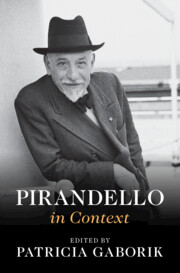Book contents
- Pirandello in Context
- Pirandello in Context
- Copyright page
- Dedication
- Contents
- Figures
- Contributors
- Preface
- Acknowledgments
- Chronology
- List of Cited Titles in Translation and the Original Italian
- Part I Places
- Part II Institutions
- Part III Interlocutors
- Part IV Traditions and Trends, Techniques and Forms
- Chapter 18 Humor
- Chapter 19 Dialect Theatre
- Chapter 20 Metatheatre
- Chapter 21 The Fourth Wall
- Chapter 22 The Anti-Character
- Chapter 23 Myth
- Chapter 24 The Fantastic
- Part V Culture and Society
- Part VI Reception and Legacy
- Further Reading
- Index
Chapter 23 - Myth
from Part IV - Traditions and Trends, Techniques and Forms
Published online by Cambridge University Press: 14 March 2024
- Pirandello in Context
- Pirandello in Context
- Copyright page
- Dedication
- Contents
- Figures
- Contributors
- Preface
- Acknowledgments
- Chronology
- List of Cited Titles in Translation and the Original Italian
- Part I Places
- Part II Institutions
- Part III Interlocutors
- Part IV Traditions and Trends, Techniques and Forms
- Chapter 18 Humor
- Chapter 19 Dialect Theatre
- Chapter 20 Metatheatre
- Chapter 21 The Fourth Wall
- Chapter 22 The Anti-Character
- Chapter 23 Myth
- Chapter 24 The Fantastic
- Part V Culture and Society
- Part VI Reception and Legacy
- Further Reading
- Index
Summary
In his essay On Humor, Pirandello effectively places himself in the tradition of Cervantes, who engaged modern problematic subjectivity, not with the tragic relativism of his contemporary Hamlet but with a nimble comic irony that learns to live within the condition. Some three centuries later, growing dissatisfied with the realist tradition Cervantes had helped to found, a number of early twentieth-century European writers, largely influenced by Nietzsche, including James Joyce, D. H. Lawrence, and Thomas Mann, turned to myth not only as a literary form but also as a form of life. In their work, the poetic imagination seeks to become mythopoeic and thereby affirm the mythic basis of human culture. In three late plays – Lazarus, The New Colony, and the unfinished The Mountain Giants – Pirandello also turned to mythic motifs, but these works are not attempts at mythopoeic creation so much as they are political and moral allegories using mythic themes.
Keywords
- Type
- Chapter
- Information
- Pirandello in Context , pp. 187 - 194Publisher: Cambridge University PressPrint publication year: 2024

